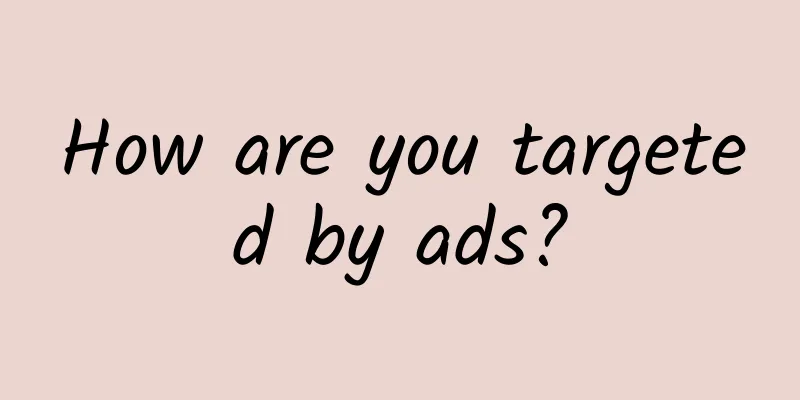Li Jiaoshou: How is a market activated?

How to use the leverage power in the market to activate the marketWhen launching new products, many companies are spending money on marketing and market. They are busy posting advertisements in elevators, buying reposts on Weibo, and brainwashing users on TV on a large scale. However, they often don’t know: what exactly are they spending money on marketing for? Yes, why on earth should we spend money? A popular view is that spending money on marketing and market is to directly bring in huge sales - when people see the advertisements, they will be attracted by the beauties, babies and selling points of the products in the advertisements, and will go crazy to buy them. This popular view is so intuitive yet so unrealistic (just think about how many times you’ve done it as a consumer) that it misleads a lot of businesses. Let’s take the real example used in the previous article again:
Why? Because in this marketing plan, all marketing is done by the company's marketing department. The truly effective marketing is done by consumers on your behalf, and the marketing department only plays the role of initial stimulation. Imagine a normal community resident, whose only channel for marketing is the advertisements in the elevator (spending the marketing department's budget), and who has no access to other free and powerful marketing methods - he will not ask his neighbor which service is good when he needs to repair his computer, nor will he use a certain computer repair service just because he sees his neighbor using that service (because residents of high-end communities in first-tier cities hardly communicate with each other). This means that all marketing costs of this O2O company are borne by its own marketing department. Real marketing experts should have this basic common sense: no company can bear the cost of all marketing activities at one time. Because the success of every marketing campaign must rely on the subsequent chain reaction: Few people place an order after seeing an advertisement, and the number is far from enough to make up for the huge cost of advertising . However, the reason why advertising is effective is that after a few people see and place an order, it can trigger a chain reaction within a group - such as recommending it to friends around them, or using the product and being seen by people around them and following suit to buy it. If a marketing campaign does not stimulate this series of chain reactions, it is equivalent to not using the huge leverage of the market and attacking the market entirely on its own strength - this is of course not possible. No company has such a powerful force that can directly change the actions of thousands of people. So, you think that marketing activities are done by the marketing department, but in fact, they are not. The main body of marketing activities is the general consumers, and the role of the marketing department is just to stimulate them to help you with marketing. Just think about your own experience of buying and trying new products (such as a new type of cosmetics) and you will know how much of it was because you saw your friends using it or were recommended by people around you (leverage power), and how much of it was because you bought it because you found it exciting after watching the advertisement (the power of the marketing department itself). Because of this, almost no marketer can implement any meaningful marketing plan (such as promoting door-to-door computer repair services in a high-end residential area in Beijing) among groups that cannot exchange ideas with each other. This is also an important reason for the failure of the company's promotion in the above case. What you really need to do is to enter a group that references each other’s opinions (the content of the previous article: "【Li Jiaoshou】People who work in marketing may not necessarily know what the ‘market’ is"), and then use a limited marketing budget to provide initial stimulation to the market, and then use the chain reactions it triggers (such as consumer discussions, demonstrations, and recommendations) to attack the market. Only in this way can we use leverage to amplify the effect of a limited market budget. So, what are the leverage forces that can be utilized within a consumer group? In fact, there are two main types of leverage that can be effectively used in the market:
The first leverage force: opinion reference effectRegarding the opinion reference effect, there is a more popular term called "word of mouth" - when consumers buy a certain product, they ask other people for their opinions, or when you use a certain product, you actively recommend it to other friends. The reason why most new products are still slow to promote even if they enter the right market segment is that they fail to effectively activate the opinion reference effect within the group. For example, I encountered such a client when doing consultation some time ago: An organic food company (Organic Hui) produces cost-effective organic food. It advertises on Focus Media, claiming that its products are organic and healthy. However, the conversion rate of the promotion is not high. Such promotional information will inevitably fail to arouse effective word-of-mouth effect within a group. Imagine that, if you actually bought this organic rice after seeing the advertisement, and then ate it, how likely are you to share it with your friends? Rarely, because this product promotes:
In short, users do not feel that the product is special, do not understand the product, and do not have the habit of discussing related topics, so they naturally will not recommend it frequently. What should I do then? After selecting a market, how to activate word of mouth? 1. Provide meaningful novelty Humans are typical social animals. At the beginning of evolution, they possessed the instinct to "share new things with their group" - if a hunter in an ancient tribe saw a wild fruit they had never seen before, or a tiger lurking nearby, they would definitely spread the news quickly throughout the tribe. This information sharing mechanism ensured the continuation of the tribe. The same is true now. When we discover a restaurant that exceeds our expectations, some interesting news, or a special lipstick, we will share it with our friends, even exaggerating it to some extent. If you want to activate this sharing and recommendation mechanism, a very important principle is to increase the novelty of the information. In contrast, the information about organic food above: advertisements about the most delicious XX, organic and ecological XX, and healthy XX have long been all over the streets and have almost no sharing value. What's more, users have no idea what "organic" means or what it represents. Therefore, we must first increase the novelty of the information: What are the advantages and features of this product and what does it contrast with? Why is this contrast meaningful? Then we discovered several characteristics of organic products: long planting cycle (cannot be ripened artificially), the land must be left fallow for three years each time it is used, a complex national certification system, and a large amount of manpower is required to eliminate pests (rather than relying on pesticides). What does this contrast with? This is of course in contrast to the current popular pursuit of efficiency, speed, industrialization and low cost. (rather than contrasting with "inorganic") Therefore, it is actually possible to package the concept of "slow" rather than the concept of "organic", because the former not only better summarizes the biggest characteristics of this type of product (slow production and high cost), but also contrasts with the fast-paced lifestyle of the target market's first-tier cities, and also implies high costs to support high prices. In short, in order to trigger discussions and recommendations within the group, it is necessary to provide novel information that can be understood ("organic" is neither novel nor difficult to understand) and find ways to break expectations. What does it mean to break expectations? When we hear someone shouting "cockroach" in the office, our eyes will first glance under the table; when we hear someone shouting "spider", our eyes will first glance towards the corner - because we have already established the knowledge of where "cockroaches" and "spiders" are generally, and the moment we hear the information, it will evoke past memories (such as cockroaches are under the table) and instantly establish expectations. Once this expectation is broken, a sense of contrast will arise. For example, if you ask a technician to come to your home to repair your computer, you already have an expectation of the technician (you might think he is a worker in blue overalls), but the person who comes is a man in Iron Man clothes, which breaks your expectation and makes you more likely to share with others. If any aspect of your product, service, marketing, etc. provides an experience that breaks expectations, users will naturally increase their sharing rate and take the initiative to talk about it with their friends. (Of course, if your product is a huge disappointment, it will also break expectations, and people will share it proactively, but it will be disadvantageous to you.) 2. Create a knowledge gap When will people take the initiative to share knowledge, information and goods? When people find that there is a "knowledge gap" on a certain issue - for example, your friend bought ordinary rice and ate it happily, but you know that this kind of rice is not healthy enough, you will have the urge to tell him that he can buy organic rice. At this time, there is a gap between your knowledge (knowing the difference between rice) and your friend's knowledge (he doesn't understand). This knowledge gap will stimulate you to actively share information with your friends, and will also stimulate your friends to actively ask you for information. If you want to stimulate users to share and trigger their chain reaction, you must find a way to create this knowledge gap - actively provide users with the necessary knowledge so that they have a sense of superiority over others. For example, when Xiaomi mobile phones were initially marketed, they vigorously promoted the huge profits in the mobile phone industry, explaining why Xiaomi had high configuration and low price, and why it could easily outsell all other high-end mobile phones. This kind of publicity makes the first wave of people who see the advertisement have more knowledge than others (for example, they know more about the mobile phone industry). They will gradually spread this knowledge in various occasions for reasons such as a sense of superiority - "So everyone uses Samsung, did you know? The cost of a Samsung phone that costs more than 4,000 yuan is about the same as that of a Xiaomi phone that costs 1,999 yuan! The mobile phone industry is..." The organic food advertisement above does not create this kind of "knowledge gap". After consumers have seen all the poster advertisements, they still will not understand what organic is and what its significance to life better than those who have not seen the advertisements. Naturally, they will not share it, and the company will not be able to leverage its market power. 3. Bind sharing topic To fully leverage your market power, you need to answer this question: When can consumers discuss you? In the organic rice advertisement above, the answer to this question is simple: it can only be discussed when consumers discuss "what is better tasting rice". But if you think about it, you will find that: Is "rice" a hot topic among consumers? Do consumers often discuss “what is the best tasting rice”? Of course not. In fact, rice is such a humble food that everyone takes for granted that consumers rarely discuss the topic. What should I do then? The general practice is to bundle the product with topics that are more easily discussed and referenced. For example, FOTILE range hood: The range hood is also a topic that we don’t discuss often. It has always been inconspicuous at home and is a durable product that is only purchased once every few years. The frequency with which it is actually discussed is probably less than that of mineral water. So last year, Fotile’s new advertisement linked range hoods, a product that is difficult to mention and discuss, to topics such as skin care, mother’s illness, and eye health. For example, "you buy high-end skin care products to maintain your skin, but they can't defeat the damage caused by low-quality range hoods" - range hoods are a low-frequency topic, but women's skin care is a high-frequency topic, and almost all young women often exchange opinions on skin care issues. Tying range hoods to skin care issues can easily arouse discussion. After all, as long as people do not exchange opinions on a certain issue, it means that you cannot use the leverage power of the group and stimulate a chain reaction through one-time marketing. Similarly, the organic rice mentioned above can also adopt the same idea and be tied to a problem that everyone often discusses and wants to solve. For example, when Xishaoye Roujiamo first came out, I wrote an entrepreneurial article that talked about the mental journey of a migrant worker in Wudaokou, Beijing, and also included the experience of being dumped by his girlfriend. Then I found that when people exchange opinions on the purchase of Roujiamo, they will mention Xishaoye. When people exchange opinions on young people's entrepreneurship, they will mention Xishaoye. When people exchange opinions on the hardships of drifting to Beijing, they will also mention Xishaoye - it is associated with many issues that people like to exchange opinions on. In short, efficient marketers will activate the target group consumers' opinions on a certain issue through initial stimulation. They will actively provide meaningful and novel information, create knowledge gaps, bind popular issues, etc., to activate consumers' chain reactions and use leverage. The second lever: the display effectIn addition to "opinion reference", another way to use the leverage power within the group is the demonstration effect, or in more common terms, "herd mentality". For example, when you see many people around you using Logitech mouse, you will also follow the crowd and buy a mouse of the same brand. This is the influence of the display effect. If the cost for Logitech to acquire a new user (who has never heard of Logitech before) entirely through advertising and other marketing methods of the marketing department is 100 yuan, then you just bought a Logitech mouse under the influence of the "display effect", which is equivalent to helping Logitech's marketing department save 100 yuan - this is a huge leverage force. For example, when you are browsing your Moments, you may see more than a dozen friends forwarding an article titled "A Universal Algorithm for Transforming Chaotic Sequences into Uniform Pseudo-Random Sequences". Even if the title is so bad that it does not use any title techniques and looks completely uninteresting, you are still likely to click on it and take a look. Because "following other people's behavior" can have a huge stimulating force on us, this force almost exceeds the maximum effect that any Y-type copywriting can achieve. For example, psychologists previously conducted an experiment to see how many people would stop and look up at the sky when they saw someone on the street looking up at the sky. Then we found that when one person on the street looked up at the sky (even if it was a meaningless action), 20% of passers-by would follow suit and look up; and once 5 people looked up at the sky, more than 80% of people would stop and look up at the sky (even if there was nothing in the sky).
So, how to improve the display effect? The simplest way is to increase the uniqueness, unity and visibility of your image so that consumers can see at a glance that other people in the group are using your product. Uniqueness: Differentiate the product image from similar products For example, Sanjin oral liquid is sold in a blue bottle, which is significantly different from similar products (Sanjin also reminds consumers in its advertisements to "look for the blue bottle"); For example, previously all headphone cables were black (for easy covering), but Apple was the first to use white headphone cables, which enhanced the uniqueness and recognition - so you can't tell at a glance who in the crowd is using AKG earbuds (because they are black), but you can tell at a glance who in the crowd is using Apple earbuds. (Of course, things have changed now.) Uniformity: All products can use unified image elements. For example, all Burberry scarves adopt a plaid design, which has a unified image recognition, making it easy for people to see whether someone around them is wearing a Burberry scarf. But if you use 10 design styles, you won’t be able to recognize it. Externality: The use of the product can be seen by others in the group. For example, if the home computer repair service is promoted in the company instead of in the community, it will increase the visibility of the computer repair service so that colleagues around you can see it - if it is at home, only you can see it. In this way, your behavior serves as a reference and demonstration to the group. Next time someone comes to get their computer repaired, they will ask, "Xiao Wang, what APP did you use last time you repaired your computer?" Through initial stimulation, allowing a certain group of people to use and demonstrate the product first, and then utilizing the demonstration effect of the group, is equivalent to effectively utilizing the leverage power in the market. ConclusionAlmost no one can succeed on their own, not even the marketing department. The role of the marketing department is not to do marketing itself, but to use the limited financial budget to give the market some initial stimulation to trigger a series of chain reactions and use the leverage in the market. There are two most commonly used lever forces:
After all, marketing is not done by the marketing department, but by consumers who are stimulated by the marketing department. The highest goal of the marketing department is that the company no longer needs a marketing department. So one result of successful marketing is: when you stop any marketing activities, the company still has new orders. (For example, even without advertising, WeChat in 2013 would automatically increase its users, mainly through chain reactions such as mutual recommendations from users) Because only in this way can it be said that you have truly and efficiently utilized the leverage power in the market. APP Top Promotion (www.opp2.com) is the top mobile APP promotion platform in China, focusing on mobile APP promotion operation methods, experience and skills, channel ASO optimization ranking, and sharing APP marketing information. Welcome to follow the official WeChat public account: appganhuo [Scan the top APP promotion WeChat QR code to get more dry goods and explosive materials] |
<<: What is the WeChat Pay merchant platform login account and password?
>>: What is the correct way to open "data analysis"?
Recommend
Google banned nearly 120,000 developer accounts in 2020
As we all know, the Google Play Store is not as s...
Winter "fashion items" also have hidden dangers, doctors urgently remind...
Review expert: Wang Xuejiang, professor at Capita...
How to do well in Baidu Q&A? How to do marketing promotion on Baidu Q&A?
There are many ways of online promotion, such as:...
Mobei Kefan Information Flow Advertising Marketing Introduction and Practical Video Tutorial (Baidu Netdisk)
The video tutorials of Mobei Class from introduct...
Let's take a look at iOS local persistent storage (focusing on the SQLite database)
The company's project has been in existence f...
Frequently asked questions about VIVO App Store CPD bidding!
CPD Bidding FAQs 1. What are the standards for pr...
100 tricks for brands to broadcast their own content
If 2021 is the first year of brand live streaming...
The world's largest third-party Android system LineageOS announced that it would stop maintaining 30 models
The name LineageOS may be unfamiliar to everyone,...
The carcinogenic incident is just an external threat. Can new retail help Starbucks solve its internal problems?
Recently, the news that Starbucks causes cancer h...
Will constant coughing lead to pneumonia? It turns out that I have always misunderstood it! How to prevent pneumonia →
Myth: "If you keep coughing, you will cough ...
Finally cool? Autumn heat: I don't exist? Please beware of this wave of "residual heat" →
The dog days are over, and it seems that there is...
8 minutes to help you quickly understand data analysis (with book recommendations)
With data analysis being so popular in the past t...
Why hasn't Google produced a product that revolutionized the world since search?
Google has been a paradise for engineers since it...
Detailed explanation of Android virtual machine Dalvik and ART
Android applications are written in Java/Kotlin. ...
Study: Sex robot market huge
Can sex robots help reduce loneliness and depress...









